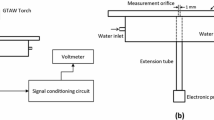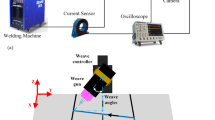Abstract
An approach has been developed to automate the gas tungsten arc welding (GTAW) process. The process temperature was monitored in-situ and employed to implement feedback control using the infrared ratio pyrometer. The automation of the process was achieved by replacing the foot pedal of the GTAW power source with an in-house developed control system consisting of a data acquisition system and a relay. The GTAW current was made variable automatically to achieve the desired or setpoint temperature. The temperature control is demonstrated for a broad range of 400–1600 °C for both stationary and moving heat source (GTAW torch). The standard deviation from the setpoint temperature was found to be within ± 25 °C for all the cases. It was also implemented for the single-pass bead deposition by feeding a low alloy steel wire to control the bead temperature in the range of 1200–1400 °C at different deposition speeds. The bead geometrical and mechanical properties could be altered by controlling the deposition temperature. The maximum bead width increased, and height decreased with the increase of the deposition temperature at a constant deposition speed. The microhardness was found to decrease by ~ 12% with the increase in deposition temperature from 1200 to 1400 °C, while the deposition speed had a marginal effect.
















Similar content being viewed by others
References
Balasubramanian, M., Jayabalan, V., & Balasubramanian, V. (2009). Effect of pulsed current gas tungsten arc welding parameters on microstructure of titanium alloy welds. Journal of Manufacturing Science and Engineering, Transactions of the ASME, 131(6), 0645021–0645024. https://doi.org/10.1115/1.4000373
Norman, A. F., Drazhner, V., & Prangnell, P. B. (1999). Effect of welding parameters on the solidification microstructure of autogenous TIG welds in an Al–Cu–Mg–Mn alloy. Materials Science and Engineering A, 259(1), 53–64. https://doi.org/10.1016/S0921-5093(98)00873-9
Keshavarz, M. K., Gontcharov, A., Lowden, P., & Brochu, M. (2020). A Comparison of weldability, structure, and mechanical properties of CM64 and Tribaloy T-800 welds for hard-facing of turbine blades. Journal of Manufacturing Science and Engineering, 142(10), 101004. https://doi.org/10.1115/1.4047142
Kumar, S., Ghosh, P. K., & Kumar, R. (2017). Surface modification of AISI 4340 steel by multi-pass TIG arcing process. Journal of Materials Processing Technology, 249(March), 394–406. https://doi.org/10.1016/j.jmatprotec.2017.06.035
Ulutan, M., Yildirim, M. M., Buytoz, S., & Çelik, O. N. (2011). Microstructure and wear behavior of TIG surface-alloyed AISI 4140 steel. Tribology Transactions, 54(1), 67–79. https://doi.org/10.1080/10402004.2010.519859
Lv, S. X., Xu, Z. W., Wang, H. T., & Yang, S. Q. (2008). Investigation on TIG cladding of copper alloy on steel plate. Science and Technology of Welding and Joining, 13(1), 10–16. https://doi.org/10.1179/174329307X249414
Panchagnula, J. S., & Simhambhatla, S. (2018). Manufacture of complex thin-walled metallic objects using weld-deposition based additive manufacturing. Robotics and Computer-Integrated Manufacturing, 49(June), 194–203. https://doi.org/10.1016/j.rcim.2017.06.003
He, W., Shi, W., Li, J., & Xie, H. (2019). In-situ monitoring and deformation characterization by optical techniques; part I: Laser-aided direct metal deposition for additive manufacturing. Optics and Lasers in Engineering, 122(June), 74–88. https://doi.org/10.1016/j.optlaseng.2019.05.020
Muvvala, G., Patra Karmakar, D., & Nath, A. K. (2017). Online monitoring of thermo-cycles and its correlation with microstructure in laser cladding of nickel based super alloy. Optics and Lasers in Engineering, 88, 139–152. https://doi.org/10.1016/j.optlaseng.2016.08.005
Kejie, D., Wentan, J., Jincheng, W., & Fuju, Z. (2010). The Research of Adaptive PID for the Thin-Walled Cylinder TIG Welding Penetration Control. In 2010 international conference on computing, control and industrial engineering (pp. 30–33). https://doi.org/10.1109/CCIE.2010.15.
Lv, N., Zhong, J., Chen, H., Lin, T., & Chen, S. (2014). Real-time control of welding penetration during robotic GTAW dynamical process by audio sensing of arc length. The International Journal of Advanced Manufacturing Technology, 74(1–4), 235–249. https://doi.org/10.1007/s00170-014-5875-7
Wu, B., Pan, Z., Ding, D., Cuiuri, D., Li, H., Xu, J., & Norrish, J. (2018). A review of the wire arc additive manufacturing of metals: Properties, defects and quality improvement. Journal of Manufacturing Processes, 35(February), 127–139. https://doi.org/10.1016/j.jmapro.2018.08.001
Williams, S. W., Martina, F., Addison, A. C., Ding, J., Pardal, G., & Colegrove, P. (2016). Wire + arc additive manufacturing. Materials Science and Technology, 32(7), 641–647. https://doi.org/10.1179/1743284715Y.0000000073
Xiong, J., & Zhang, G. (2014). Adaptive control of deposited height in GMAW-based layer additive manufacturing. Journal of Materials Processing Technology, 214(4), 962–968. https://doi.org/10.1016/j.jmatprotec.2013.11.014
Huang, X. K., Tian, X. Y., Zhong, Q., He, S. W., Huo, C. B., Cao, Y., Tong, Z. Q., & Li, D. C. (2020). Real-time process control of powder bed fusion by monitoring dynamic temperature field. Advances in Manufacturing, 8(3), 380–391. https://doi.org/10.1007/s40436-020-00317-y
Khan, A. U., & Madhukar, Y. K. (2020). An economic design and development of the wire arc additive manufacturing setup. Procedia CIRP, 91, 182–187. https://doi.org/10.1016/j.procir.2020.02.166
Khan, A., & Madhukar, Y. K. (2021). Effects of pillar-based substrate on the wire arc additive manufacturing process. International Journal of Precision Engineering and Manufacturing. https://doi.org/10.1007/s12541-021-00529-7
IMPAC Pyrometers IGAR 6 Advanced manual. LumaSense Technologies. https://www.advancedenergy.com/globalassets/resources-root/manuals/en-op-igar-6-advanced-manual.pdf
Zohuri, B. (2018). Cryogenic technologies. Physics of Cryogenics. https://doi.org/10.1016/b978-0-12-814519-7.00001-x
Müller, B., & Renz, U. (2001). Development of a fast fiber-optic two-color pyrometer for the temperature measurement of surfaces with varying emissivities. Review of Scientific Instruments, 72(8), 3366–3374. https://doi.org/10.1063/1.1384448
Verret, D. P., & Ramanathan, K. G. (1978). Total Hemispherical Emissivity of Tungsten. Journal of the Optical Society of America, 68(9), 1167–1172. https://doi.org/10.1364/JOSA.68.001167
Wang, H., Chen, D., Wang, G., Long, Y., Luo, J., Liu, L., & Yang, Q. (2013). Measurement technology for material emissivity under high temperature dynamic heating conditions. Measurement: Journal of the International Measurement Confederation, 46(10), 4023–4031. https://doi.org/10.1016/j.measurement.2013.07.041
NENIR501B Ø1/2’ Unmounted NIR Absorptive ND Filter, OD: 0.1. (2021). Thorlabs. www.thorlabs.com/thorproduct.cfm?partnumber=NENIR501B.
Uhrlandt, D., Baeva, M., Pipa, A. V., Kozakov, R., & Gött, G. (2014). Cathode fall voltage of TIG arcs from a non-equilibrium arc model. Welding in the World, 59(1), 127–135. https://doi.org/10.1007/s40194-014-0188-x
Yan, Z., Liu, W., Tang, Z., Liu, X., Zhang, N., Li, M., & Zhang, H. (2018). Review on thermal analysis in laser-based additive manufacturing. Optics and Laser Technology, 106, 427–441. https://doi.org/10.1016/j.optlastec.2018.04.034
Suryana, Pramono, A., Muda, I., & Setiawan, A. (2019). The influence of heat input to mechanical properties and microstructures of API 5L–X65 steel using submerged arc welding process. MATEC Web of Conferences, 269, 01009. https://doi.org/10.1051/matecconf/201926901009
EuropeanStandards. (2000). Welding recommendations for welding of metallic materials—Part 2: Arc welding of ferritic steels. Ds/En 1011-2, 3(1), 26.
Acknowledgements
The authors would like to thank the technical staff of Central Workshop IIT Indore for their consistent help and support. They also thank Dr Satyajit Chatterjee for allowing to access the Tribology Laboratory facilities. Extended help from the Department of Mechanical Engineering, IIT Indore, is gratefully acknowledged.
Funding
This work was supported by the Science and Engineering Research Board, India [CRG/2020/001068] under the CRG scheme.
Author information
Authors and Affiliations
Corresponding author
Additional information
Publisher's Note
Springer Nature remains neutral with regard to jurisdictional claims in published maps and institutional affiliations.
Rights and permissions
Springer Nature or its licensor holds exclusive rights to this article under a publishing agreement with the author(s) or other rightsholder(s); author self-archiving of the accepted manuscript version of this article is solely governed by the terms of such publishing agreement and applicable law.
About this article
Cite this article
Khan, A.U., Patidar, M. & Madhukar, Y.K. In-Situ Temperature Monitoring and Feedback Control in the Gas Tungsten Arc Welding Process. Int. J. Precis. Eng. Manuf. 23, 1367–1380 (2022). https://doi.org/10.1007/s12541-022-00704-4
Received:
Revised:
Accepted:
Published:
Issue Date:
DOI: https://doi.org/10.1007/s12541-022-00704-4




